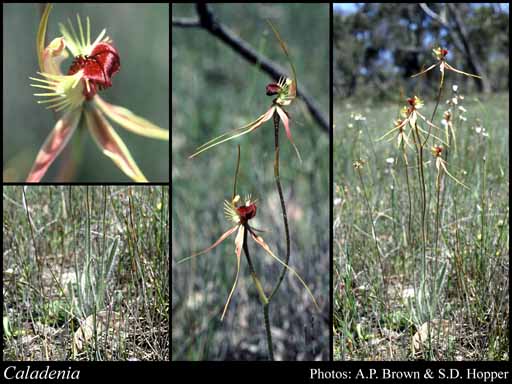- Reference
- Prodr.Fl.Nov.Holland. 323 (1810)
- Name Status
- Current







Scientific Description
Family Orchidaceae.
Habit and leaf form. Herbs. Perennial. Leaves basal. Tuberous (tuber rounded, white, wholly or partially enclosed in a shaggy, fibrous sheath). Helophytic, or mesophytic. Leaves medium-sized to very large; ‘herbaceous’, or leathery, or fleshy; petiolate; simple. Leaf blades entire; flat; elongate; parallel-veined; cross-venulate, or without cross-venules. Leaf blade margins entire. Vernation conduplicate. Leaf anatomy. Hairs present (hairs with enlarged basal cell). Stem anatomy. Secondary thickening absent.
Reproductive type, pollination. Fertile flowers hermaphrodite. Unisexual flowers absent. Plants hermaphrodite. Entomophilous, or pollinated by unusual means (self-pollinating). Pollination mechanism conspicuously specialized (in some species the expanded tips of the sepals and petals, known as ‘clubs’, are believed to be the source of sexual attractants for male Thynnid wasps; some have a modified labellum that loosely mimics the flightless female Thynnid wasp; many of the smaller species produce scented, brightly coloured flowers that attract native bees and beetle pollinators).
Inflorescence and flower features. Flowers solitary, or aggregated in ‘inflorescences’. Inflorescence few-flowered to many-flowered. Flowers in racemes (loose). The terminal inflorescence unit racemose. Inflorescences scapiflorous, or not scapiflorous; terminal; stem bract 1, usually spreading and conspicuous. Flowers pedicellate; small to very large; fragrant, or odourless; very irregular; zygomorphic; resupinate. The floral asymmetry involving the perianth and involving the androecium. Flowers 3 merous; cyclic; supposedly basically pentacyclic. Perigone tube absent. Perianth of ‘tepals’, or with distinct calyx and corolla; 6; 2 -whorled; isomerous (but zygomorphic); free; without spots, or spotted; green, or white, or cream, or yellow, or red, or pink, or purple. Calyx (if the outer whorl be so designated) 3 (the median member ostensibly posterior), or 5 (by misinterpretation); 1 -whorled; polysepalous. Corolla (i.e. the members of the inner whorl) 3, or 1 (by misinterpretation); polypetalous; imbricate. Androecium 3, or 1 (by misinterpretation). Androecial members free of the perianth; united with the gynoecium (fused with the style to form a column or ‘gynostemium’; column usually terminating in a definite point); coherent (via the gynostemium); 1 - adelphous; theoretically 2 -whorled. Androecium including staminodes, or exclusively of fertile stamens (by misinterpretation). Staminodes 2 (these anterior (ostensibly posterior), supposedly the abaxial pair of the inner whorl). Stamens 1 (this across the flower from the labellum, i.e. anterior but ostensibly posterior, supposedly representing the outer whorl); reduced in number relative to the adjacent perianth; alterniperianthial (i.e. with reference to the single stamen, across the flower from the labellum); filantherous, or with sessile anthers. Anthers dorsifixed to basifixed; dehiscing via longitudinal slits; introrse; tetrasporangiate; appendaged, or unappendaged. Pollen shed in aggregates; in the form of pollinia. Gynoecium 3 carpelled. The pistil 1 celled. Carpels isomerous with the perianth. Gynoecium syncarpous; eu-syncarpous; inferior. Ovary unilocular; 1 locular. The ‘odd’ carpel anterior (away from the labellum). Gynoecium stylate. Styles 1 (inflexed); apical. Stigmas 1; 3 - lobed (but becoming much modified in form, the apex of the median lobe forming the ‘rostellum’); wet type; papillate; Group III type. Placentation parietal. Ovules not differentiated; in the single cavity 30–100 (i.e. very numerous); non-arillate; anatropous.
Fruit and seed features. Fruit non-fleshy; dehiscent; a capsule. Capsules septicidal, or loculicidal. Fruit 30–500 seeded (i.e. seeds usually very numerous). Seeds endospermic (endosperm development arrested very early), or non-endospermic; minute; without starch. Embryo rudimentary at the time of seed release, or weakly differentiated. Seedling. Seedling collar not conspicuous. Primary root ephemeral.
Geography, cytology, number of species. Native of Australia. Not endemic to Australia. Australian states and territories: Western Australia, South Australia, New South Wales, Victoria, Australian Capital Territory, and Tasmania. South-West Botanical Province.
Additional characters Perianth of 5 similar members and the median inner member modified into the labellum (sepals and lateral petals obtuse to long-acuminate; adaxial sepal usually erect, lateral sepals and petals often widely spreading; labellum usually shortly clawed, usually recurved at the apex, often laterally fringed or toothed). Leaves solitary. Leaves erect. Column prominently winged. Labellum insect-like, or not insect-like. Perianth not glossy. Labellum with calli (on the limb; calli sessile or stipitate, densely crowded or in distinct rows). Hairs with an enlarged basal cell.
Taxonomic Literature
- Brown, Andrew P.; Brockman, Garry 2007. Caladenia petrensis and C. saxicola (Orchidaceae), two new ironstone endemics from south-west Western Australia.
- Wheeler, Judy; Marchant, Neville; Lewington, Margaret; Graham, Lorraine 2002. Flora of the south west, Bunbury, Augusta, Denmark. Volume 1, introduction, keys, ferns to monocotyledons. Australian Biological Resources Study.. Canberra..
- Hopper, Stephen D.; Brown, Andrew P. 2001. Contributions to Western Australian orchidology. 1, history of early collections, taxonomic concepts and key to genera.
- Brown, Andrew; Hoffman, Noel 1995. Orchids of south-west Australia. University of W.A. Press.. Nedlands, W.A..
- Heberle, R. L. 1995. Taxonomic treatment of Caladenia in south western Australia : appraisal, 1995.
- George, A. S. 1984. Seven new orchids from Western Australia.